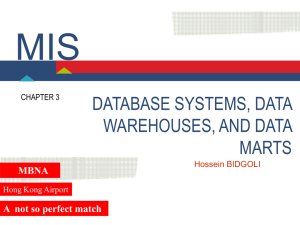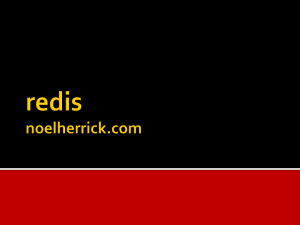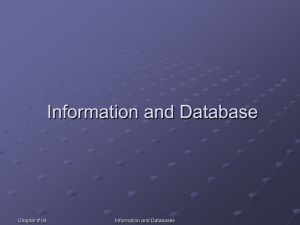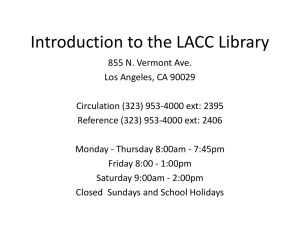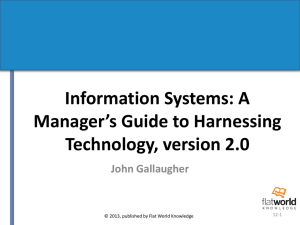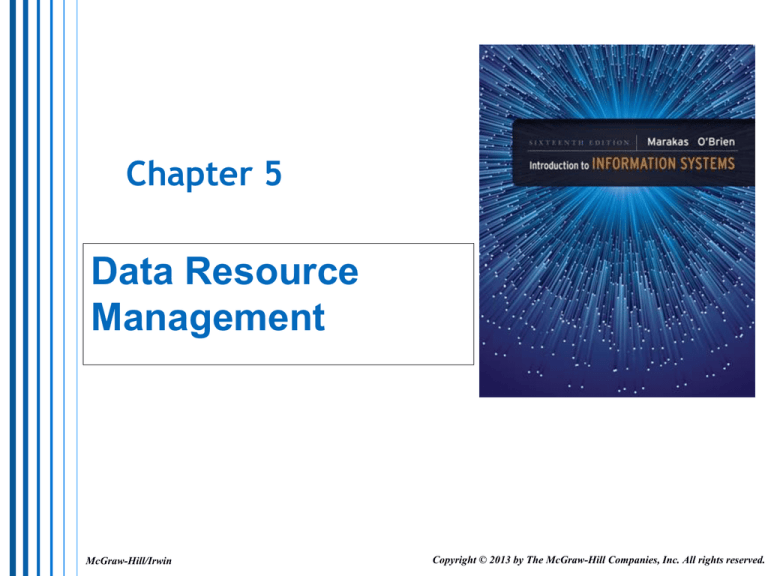
Chapter 5
Data Resource
Management
McGraw-Hill/Irwin
Copyright © 2013 by The McGraw-Hill Companies, Inc. All rights reserved.
Learning Objectives
Explain the value of implementing data resource
management processes and technologies in an
organization.
Outline the advantages of a database management
approach to managing the data resources of a
business, compared with a file processing approach.
Explain how database management software helps
business professionals and supports the operations
and management of a business.
5-2
Learning Objectives
Provide examples to illustrate each of the
following concepts:
Major types of databases
Data warehouses and data mining
Logical data elements
Fundamental database structures
Database development
5-3
Section 1
Technical Foundations of Database
Management
5-4
I. Database Management System
Data resources must be structured and
organized in some logical manner so
they can be accessed, processed,
retrieved, and managed easily
5-5
II. Fundamental Data Concepts
Character – the most basic logical data
element that can be observed, a single
alpha or numeric or other symbol,
represented by one byte
Field – a grouping of related characters,
as a last name or a salary, represents an
attribute of some entity General Purpose
Application Programs – perform
common information processing jobs for
end users
5-6
II. Fundamental Data Concepts
Record – a grouping of attributes that
describe an entity
File – a group of related data records
Database – a collection of logically
related data elements
5-7
II. Fundamental Data Concepts
5-8
III. Database Structures (Models)
Hierarchical Structure – treelike structure of oneto-many parent-child relationships (each child can
have only one parent)
Network Structure – similar to hierarchical but
allows many-to-many relationships (a child record
can have more than one parent)
Relational Structure – the most widely used
database model today; data is represented as a
series of two-dimensional tables called Relations;
each column is a named attribute of the entity,
each row is an unnamed instance of that entity
5-9
III. Database Structures (Models)
Relational Operations
Select – create a subset that meets a criterion
Join – temporarily combine two or more tables for
comparison
Project – create a subset of the columns in the
temporary tables
Multidimensional Structure – variation of the
Relational model using multidimensional
structures to organize and express
relationships
5-10
III. Database Structures (Models)
5-11
III. Database Structures (Models)
5-12
III. Database Structures (Models)
5-13
III. Database Structures (Models)
Object-Oriented Structure – combining the
data of interest and the processes that act on
that data into a structure called an object
Encapsulation – allows complex data types
Inheritance – allows replication of some/all of the
characteristics of a parent object in the creation of
a child object
Evaluation of Database Structures – databases
have grown more complex as needs have
changed and grown in complexity
5-14
III. Database Structures (Models)
5-15
Database Pioneer Rethinks the Best Way
to Organize Data
How do databases currently focus on
data to be stored?
What is suggested as a better away to
focus on data warehouses?
What gains do these changes promise?
5-16
IV. Database Development
Database Administrator (DBA) – controls
development and administration of the
database
Data Definition Language (DDL) – used to
specify the contents, relationships, and
structure of the database
Data Dictionary – directory containing the
metadata
5-17
IV. Database Development
Metadata – data about the data
Data Planning and Database Design
Data Modeling (Entity-Relationship Diagrams) –
logical models of the data itself; this must be done
before choosing the database model
Schema – the physical/internal view of a system
Subschema – the logical/external view of a system
5-18
IV. Database Development
5-19
IV. Database Development
Entity Relationship Diagram
5-20
AAA Missouri: Data Quality Is an
Important First Step
What problem did AAA Missouri have?
How does Melissa solve this problem?
What other benefits does this software
provide?
What is the ultimate goal of using this
software? What business benefit will
that provide?
5-21
Hadoop: Ready for the Large-scale
Databases of the Future
What is the strength of Hadoop?
What does Hadoop do differently from
pervious databases?
Why do we need something different
today for handling data in databases?
What does this tell you about the future
od handling data?
5-22
Section 2
Managing Data Resources
5-23
I. Data Resource Management
Data are an organizational resource that
must be managed as any other resource
5-24
I. Data Resource Management
Types of Databases Used by
Organizations and End-Users
5-25
II. Types of Databases
Operational Databases – store detailed data to
support business processes and operations
Distributed Databases – many organizations
distribute their databases over multiple
locations
Replication – complex process of updating
distributed data
Duplication – simplified method of updating
distributed data
5-26
II. Types of Databases
External Databases – outside the firm,
free or fee-based
Hypermedia Databases – hyperlinked
pages of multimedia
5-27
Coty: Using Real-Time Analytics to Track
Demand
What percentage of retails products are
usually out of stock in the U.S.?
What percentage of promotional items
are usually out of stock in the U.S.?
What effect does this have on business?
How does Coty deal with these issues?
5-28
III. Data Warehouses and Data Mining
Data Warehouse – stores data extracted
from other databases
Data Mart – subset of a data warehouse
focusing on a single topic, customer,
product, etc.
Data Mining – analyzing a data
warehouse to reveal hidden patterns
and trends
5-29
III. Data Warehouses and Data Mining
Components of a Data Warehouse System
5-30
III. Data Warehouses and Data Mining
A Data Warehouse and its Data Mart Subsets
5-31
III. Data Warehouses and Data Mining
Data Mining Extracts Business Knowledge
from a Data Warehouse
5-32
Better Analytics Means Better Care
According to this case, what is the state
of healthcare and BI?
In what ways did the system improve
patients’ health?
How does SETMA view the cost and
benefits of the system?
5-33
IV. Traditional File Processing
Data was stored in independent files without
regard to other needs for that data
Problems of File Processing – databases seek
to solve these problems
1. Data Redundancy – the same data is kept in
more than one location; databases seek to
Control (NOT reduce!) Redundancy; this led to
Data Inconsistency – same data in multiple
locations but the Values were Different
5-34
IV. Traditional File Processing
Problems of File Processing – databases seek
to solve these problems
2. Lack of data Integration – data not easily
available for ad hoc requests
3. Data Dependence – data and programs were
“tightly coupled”, changing one meant having to
change the other
4. Lack of Data Integrity (Standardization) – data
was defined differently by different end users or
applications
5-35
Online Dating: The Technology Behind
Finding Love
Are all dating sites the same? For users,
what makes the difference between
different dating sites?
What is the biggest challenge for
eHarmony?
When is the demand for eHarmony’s
services greatest? Why might this be?
What does this mean from a business
perspective?
5-36
V. Database Management Approach
Consolidate the data from separate files into
databases accessible by multiple application
programs
Database Management System (DBMS) – a
collection of programs to create, maintain, and use
(retrieve) data in a database
Database Maintenance – organizational databases
need to be updated continually
Application Development – facilitated by the Data
Manipulation Language (DML) provided by the
DBMS
5-37
V. Database Management Approach
Database Interrogation – query (“ask”) the
database for information
Query Language – allows ad hoc requests of the
database
SQL Queries (Structured Query Language) –
standard query language found in many
databases
Boolean Logic – 3 logical operators: AND, OR,
and NOT
Graphical and Natural Queries – easier methods
of structuring SQL statements
5-38

